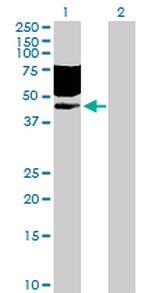Search Thermo Fisher Scientific
FIGURE: 1 / 1
CD96 Antibody (H00010225-D01P) in WB
Lane 1: CD96 transfected lysate(45.60 KDa).
Lane 2: Non-transfected lysate.

Product Details
H00010225-D01P
Species Reactivity
Host/Isotype
Class
Type
Immunogen
Conjugate
Form
Concentration
Purification
Storage buffer
Contains
Storage conditions
Shipping conditions
Product Specific Information
Sequence of this protein is as follows: MEKKWKYCAV YYIIQIHFVK GVWEKTVNTE ENVYATLGSD VNLTCQTQTV GFFVQMQWSK VTNKIDLIAV YHPQYGFYCA YGRPCESLVT FTETPENGSK WTLHLRNMSC SVSGRYECML VLYPEGIQTK IYNLLIQTHV TADEWNSNHT IEIEINQTLE IPCFQNSSSK ISSEFTYAWS VEDNGTQETL ISQNHLISNS TLLKDRVKLG TDYRLHLSPV QIFDDGRKFS CHIRVGPNKI LRSSTTVKVF AKPEIPVIVE NNSTDVLVER RFTCLLKNVF PKANITWFID GSFLHDEKEG IYITNEERKG KDGFLELKSV LTRVHSNKPA QSDNLTIWCM ALSPVPGNKV WNISSEKITF LLGSEISSTD PPLSVTESTL DTQPSPASSV SPASKNVFTL SY
Target Information
CD96 is a cell adhesion receptor also known as TACTILE. A member of the Ig superfamily, CD96 is a single pass transmembrane protein consisting of three extracellular Ig-like domains and a proline/serine/threonine rich region. CD96 is expressed on resident monocytes and T cells at all developmental stages (including gamma-delta T cells, thymocytes, and NK cells). In the mouse, this receptor is not expressed on B cells. Unlike in humans, mouse CD96 does not exist as alternative splice variants. Reports indicate that CD96 binds CD155/poliovirus receptor and Nectin-1 to mediate NK cell adhesion to target cells and cytotoxicity.
For Research Use Only. Not for use in diagnostic procedures. Not for resale without express authorization.
References (0)
Bioinformatics
Protein Aliases: CD96; Cell surface antigen CD96; DKFZp667E2122; sCD96; soluble CD96; T cell activation, increased late expression; T cell-activated increased late expression protein; T-cell surface protein tactile
Gene Aliases: CD96; TACTILE
UniProt ID: (Human) P40200
Entrez Gene ID: (Human) 10225

Performance Guarantee
If an Invitrogen™ antibody doesn't perform as described on our website or datasheet,we'll replace the product at no cost to you, or provide you with a credit for a future purchase.*
Learn more
We're here to help
Get expert recommendations for common problems or connect directly with an on staff expert for technical assistance related to applications, equipment and general product use.
Contact tech support
